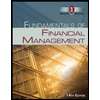
1
Leveraged buyout
Leveraged buyout is a process under which a company purchases or acquires majority of shares of some other company by using the borrowed money or debt.
To explain:The meaning of leverage buyout and to explain that how it is different from a management buyout.
2
Leveraged buyout
Leveraged buyout is a process under which a company purchases or acquires majority of shares of some other company by using the borrowed money or debt.
To explain:Various regulations issued in respect of leveraged buyout.
3
Business combination
Business combination refers to a transaction by a which a company purchases majority of shares (more than 50 percent) of some other existing company and obtains the control of other company.
Whether a leveraged buyout can be considered as a form of business combination.
4
Leveraged buyout
Leveraged buyout is a process under which a company purchases or acquires majority of shares of some other company by using the borrowed money or debt.
To explain:Why it is hard to determineinterest in a company when it is purchased through a leveraged buyout.
Want to see the full answer?
Check out a sample textbook solution
Chapter 1 Solutions
Advanced Financial Accounting
- Please provide the solution to this general accounting question with accurate financial calculations.arrow_forwardI need help solving this general accounting question with the proper methodology.arrow_forwardPlease show me the correct way to solve this financial accounting problem with accurate methods.arrow_forward
- What is the predetermined manufacturing overhead rate ??arrow_forwardAccounting questionsarrow_forwardLivia's Pastries produces cupcakes, which sell for $6.50 each. During the current month, Livia produced 4,600 cupcakes, but only sold 4,200. The variable cost per cupcake was $3.60, and the sales commission per cupcake was $0.55. Total fixed manufacturing costs were $2,700, and total fixed marketing and administrative costs were $2,000. What is the product cost per cupcake under absorption costing?arrow_forward
- Winston Filters manufactures a unique reverse osmosis filter. The budgeted indirect total cost of assembling the filter is $160,000. The budgeted number of filters to be assembled is 40,000. What is the budgeted indirect cost allocation rate for this activity? a. $4.00 b. $3.80 c. $3.50 d. $4.20arrow_forward???arrow_forwardWhat effect will the order have on the company's short-term profit ? accountingarrow_forward
- Can you solve this financial accounting problem with appropriate steps and explanations?arrow_forwardSmith Manufacturing estimates that its employees will utilize150,000 machine hours during the coming year. Total overhead costs are estimated to be $6,000,000, and direct labor hours are estimated to be 90,000.Actual machine hours are 110,000, and actual labor hours are 70,000. If Smith Manufacturing allocates overhead based on machine hours, what is the predetermined manufacturing overhead rate?arrow_forwardWhich of the following is a current liability? (a)Notes Payable (due in 2 years) (b)Bonds Payable (c)Equipment (d)Unearned Revenuearrow_forward
 Fundamentals Of Financial Management, Concise Edi...FinanceISBN:9781337902571Author:Eugene F. Brigham, Joel F. HoustonPublisher:Cengage Learning
Fundamentals Of Financial Management, Concise Edi...FinanceISBN:9781337902571Author:Eugene F. Brigham, Joel F. HoustonPublisher:Cengage Learning Fundamentals of Financial Management (MindTap Cou...FinanceISBN:9781337395250Author:Eugene F. Brigham, Joel F. HoustonPublisher:Cengage Learning
Fundamentals of Financial Management (MindTap Cou...FinanceISBN:9781337395250Author:Eugene F. Brigham, Joel F. HoustonPublisher:Cengage Learning Fundamentals of Financial Management (MindTap Cou...FinanceISBN:9781285867977Author:Eugene F. Brigham, Joel F. HoustonPublisher:Cengage Learning
Fundamentals of Financial Management (MindTap Cou...FinanceISBN:9781285867977Author:Eugene F. Brigham, Joel F. HoustonPublisher:Cengage Learning



